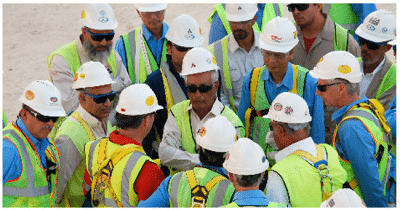Japanese engineering and construction corporation achieves breakthrough improvement in safety performance
The JGC Corporation built a new safety culture across its entire organization, positively impacting local and overseas projects.



The JGC Corporation built a new safety culture across its entire organization, positively impacting local and overseas projects.
The JGC Corporation based in Yokohama, Japan built a new safety culture across its entire organization, positively impacting local and overseas projects.
With its experience on the Shell Pearl GTL project, JGC’s management recognized the potential of the Incident and Injury-Free™ (IIF™) safety approach very quickly. It became their model project.
JGC’s first involvement with IIF was in 2007, on the Shell Pearl GTL project in Ras Laffan, Qatar. The client, Qatar Shell GTL Limited, partnered with JMJ to implement the IIF safety approach across the entire project. In the first year of the project 10,000 workers completed their IIF Orientation training, with the remaining workers and new arrivals completing their training the following year. The training became effective as a leadership and safety culture development initiative when the project culture started to change. The workforce responded positively and adopted new attitudes to safety.

From 2010, it implemented the IIF safety approach on more than ten of its overseas projects including the Integrated Gas Development (IGD) project in Abu Dhabi and the Donggi-Senoro LNG project in Indonesia.
In 2011, JGC’s management introduced a safety culture change initiative for its local projects with a similar approach to the IIF safety approach, under the name of ‘Ii Fureai’, which means ‘close relationship’.
Corporate wide safety culture activities are now also influencing JGC’s subcontractors, joint venture partners, clients, module fabricators and vendors. The organization has transformed its safety culture and achieved best in class safety performances on all its projects.
64% reduction in Total Recordable Injury Rate (TRIR). Lower than predicted.